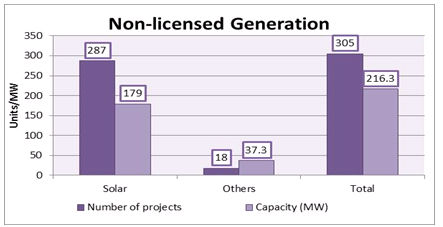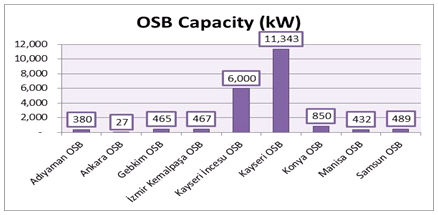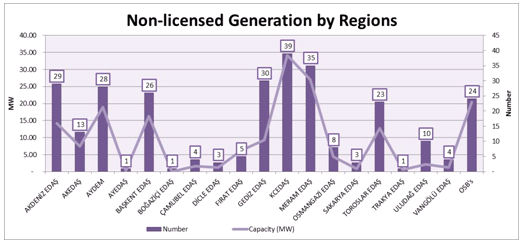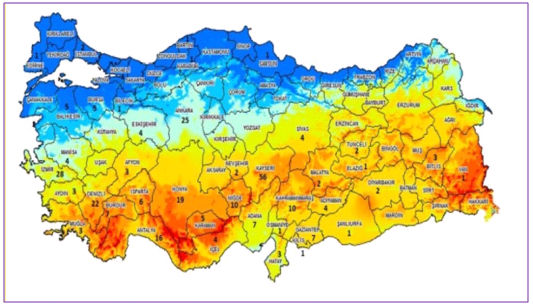1. Overview
The amendments in the legislative and regulatory landscape regarding the electricity market in 2013 have paved the way for a rally towards non-license power generation based on renewable resources. The increase in the capacity allowed for non-license generation to 1 MW together with the increase in the attractiveness of the feed-in tariff prices (due partly to exchange rates and partly to the low levels of wholesale prices) are deemed responsible for such a rally. Both domestic and international investors are now highly interested in and have actually been involved in non-license power generation.

Non-license power generation based on solar turned out to be most attractive type. Based on Turkey Electricity Distribution Company (TEDAŞ) data published on 16 September 2015, 287 out of 305 projects that have been commissioned (approved by TEDAŞ) are solar based. The total capacity of 305 projects is 216.3 MW while the total capacity of 287 solar projects is 179 MW.

An even distribution is not being observed among distribution regions. Ignoring organized industrial zones (OSBs), 61% of the installed capacity is located in four distribution regions only that are AYDEM EDAŞ, BAŞKENT EDAŞ, KCETAŞ and MERAM EDAŞ. Three out of 21 regions do not have solar based non-license power generation. OSBs, on the other hand, have proved to be very active in commissioning solar non-licensed power plants. Given TEDAŞ data, more than 11% of the commissioned capacity falls within the OSB boundaries led again by Kayseri OSB. Kayseri OSB and Kayseri İncesu OSB alone account for 85% of the capacity built in OSB regions.

Based on both the number of projects and installed capacity, Kayseri province takes the lead with a total number of 56 projects and a total capacity of around 52 MW. In a recent study Solarbaba comparatively assessed the commissioned plants and the solar map of the country.1 The results revealed that, as expected, the commissioned projects are concentrated in regions where depicted as efficient by the solar map.

2. Reasons for popularity
In order to assess the underlying logic of this rally on solar power, one needs to look at three distinct issues:
- Comparative price levels
- Licensing regime
- Non-requirement of self-consumption and siting
- Comparative price levels
The feed-in tariff levels as applied according to the Law on Utilization of Renewable Energy Sources for the Purpose of Generating Electrical Energy (the Renewable Energy Law) are denominated in US cents thus cash-flows for the projects are directly dependent on the Turkish Lira (TRY) value of 1 US dollar (USD) for the given settlement period. TRY, on the other hand, has depreciated on a large scale against USD in recent several years. The journey of TRY depreciation is depicted in below chart based on Central Bank of Turkey (TCMB) data:

As shown in the graph, USD appreciation/TRY depreciation has gained momentum in the second half of 2014 and continued in the course of 2015. Considering that the feed-in tariff is 133 US cents/MWh for solar power, it can be observed that in TRY terms the companies were able to receive 240 TRY/MWh in the beginning of 2013 compared to 386 TRY/MWh. As the TL value of the feed-in tariff increases due to depreciation of the domestic currency, the interest in building non-license solar power plants has become increasingly popular.
Although, more essential for licensed Renewable Energy Support Mechanism (YEKDEM) participants, the power prices in the wholesale electricity market also had an impact on the rally to renewable based power generation and non-licensed generation. For power plants operating under a generation license, the wholesale prices compared to applicable feed-in tariffs are critical and decisive in participating in YEKDEM or selling in the wholesale market. From this perspective, in TRY terms, feed-in tariffs have become considerably higher than the wholesale market prices. More specifically, as of 2015, average wholesale price of electricity turned out to be around 49 USD while feed-in tariff for solar is 133 USD. Although non-license power generation cannot be sold on the wholesale market, the price differentiation between wholesale prices and feed-in tariffs increases the attractiveness of the renewable support system overall.

- Licensing regime
Licensing regime and the associated transaction costs are another important reason underlying the popularity of non-license power generating based on solar. Different from other types of generation licenses, licensing process for wind and solar are quite different.
First of all, applications for wind and solar licenses are received once a year and within only several days (window regime). Second, minimum one year of measurement is required for the fields that are selected for siting. Third, since the capacity announced by Türkiye Elektrik Üretim A.Ş. (TEİAŞ) is limited, applicants bid to obtain the announced capacities at specific transformators. These transactions not only prolong the process but also create additional costs for the applicants. For non-license generation, on the other hand, companies do not have to follow these steps and directly commission the plant through signing the connection agreements with the distribution system operator (DSO). The fundamental difference between licensed and non-license generation is the fact the capacity for the latter is limited to 1 MW.
- Non-requirement of self-consumption and siting
First of all, from a theoretical perspective, it should be stated that the overarching principle governing non-license power generation is self-consumption. This principle is also stated in the Regulation on Non-License Power Generation (Regulation). However, Energy Market Regulatory Authority (EMRA) allows non-license generation without any considerable consumption (one lamp is sufficient for one MW plant). Thus, any company willing to build a solar power plant without license is not required to have any facility to have consumption.
Second, restriction on the capacity has become abated due to the siting practices. That is, by locating more than one 1 MW plants side by side is accepted by TEDAŞ and EMRA. As a consequence, in practice, more than 1 MW capacity is being built and operated by a single company at the same location.
3. Conclusion:
The above analysis is an attempt to explain the drivers behind the current popularity in non-license solar projects in Turkey. As explained, the regulatory incentives together with the convenient macroeconomic indicators helped solar investors find their way in non-license generation business on an increasing scale. As mentioned, both domestic and international investors have shown interest in building non-license solar projects in Turkey.
Last but not least, the cost of generating electricity from solar panels is also decreasing. Indeed, the levelized cost of energy (LCOE) from photovoltaic (PV) systems is already below retail electricity prices (per-kWh charge) in several countries, and rapidly approaching the level of generation costs from conventional alternatives, especially new coal with strict air pollutant emission standards, new nuclear plants with increased safety standards, or new gas plants in areas with high gas prices.2
This popularity seems to continue in the foreseeable future. Although it is desirable to have more renewable based power generation in the national portfolio, concerns are also being expressed by some circles as the spread between wholesale prices and the feed-in tariffs expand. These concerns should also be addressed appropriately for the sustainability of the support mechanism.
Footnotes
1 http://www.solarbaba.com/dosya/110-lisanssiz-ges-raporu
2 IEA, « Technology Roadmap : Solar Photovoltaic Energy", 2014 edition.
The content of this article is intended to provide a general guide to the subject matter. Specialist advice should be sought about your specific circumstances.

